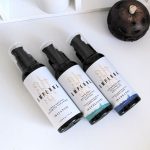There’s a new paper on zinc oxide sunscreens not working and becoming toxic after 2 hours of UV exposure. A lot of people have sent me this paper, so here’s my analysis of it.
In short, the researchers found that sunscreen ingredients broke down when mixed with zinc oxide and exposed to UV light, and the degraded mixtures had lower UVA protection and were toxic to zebrafish embryos.
I don’t think the conditions used in the study reflect what goes on in a modern sunscreen, but some issues that were raised about sunscreens are valid (although many of these issues have been known for decades already).
Summary of the study
The researchers dissolved 5 mixtures of chemical filters in DMSO (DMSO or dimethyl sulfoxide is a solvent commonly used in research that’s especially good for dissolving substances and enhancing penetration through skin). They put the mixtures under a light that replicated sunlight for 120 minutes. (These mixtures reflect the active ingredients in real-life SPF 15 sunscreens.)
They also did this with uncoated microparticle (20-1000 nm) and nanoparticle (<100 nm) zinc oxide added to separate samples of one of the original mixtures.
They measured the UV absorption of each mixture (the greater the UV absorption the better the UV protection, since that’s how sunscreens work – they absorb UV before it hits your skin).
They also tested the effects of the mixtures on zebrafish embryos. Zebrafish are commonly used as models for humans since we share a lot of similar genes, but there are obviously still lots of differences between zebrafish embryos and human skin. They are also used to investigate toxicity to aquatic life.
The results:
- Chemical sunscreen-only mixtures were largely unchanged after UV exposure:
- UV absorption was largely the same before and after UV exposure, meaning that the sunscreens were mostly photostable (didn’t break down in UV light).
- Toxicity to zebrafish embryos was minimal.
- Chemical sunscreens + zinc oxide mixtures were very different after UV exposure:
- UVA protection was significantly decreased (calculated UVAPF dropped by 91.8% for microparticles and 84.3% for nanoparticles) – this can be explained by avobenzone decomposing
- Toxicity to zebrafish embryos increased with mixtures containing zinc oxide after UV exposure.
Sunscreens aren’t just active ingredients in solution
This to me is by far the most glaring issue with their methodology, and severely limits how applicable the results are to real sunscreens and how we use them.
The researchers seem to think that actives degrading in UV while sitting in DMSO are pretty similar to actives in a real sunscreen degrading in UV on human skin.
Two big problems with this assumption:
Real sunscreens and solutions don’t interact with light the same way
When you apply sunscreen on your skin, they dry down and much of the solvents in the sunscreens evaporate or absorb into skin. The sunscreening ingredients end up much closer together and interact with each other a lot more, changing their UV protection properties. The filters are a lot less free to move around than they are when dissolved into a liquid… which means they’re also not going to react as much with each other.
UV also interacts differently with films than with solutions – I discussed this in detail in my post on SPF testing.
This is why sunscreen testing labs usually go to the trouble of smearing sunscreen evenly on specially roughened PMMA plates and letting them dry down to form a film before testing for photostability. The authors mention the problems they had trying to do this in their lab, but there are many testing labs that have refined how they conduct these tests (some methodologies have been published as well). And even then, there’s a lot of debate about whether or not this reflects what actually happens on human skin. This is why there isn’t a standard test for photostability, like there is for SPF (UVA protection testing is a bit less settled than SPF, although it’s getting there).
The authors claim that DMSO might stabilise sunscreen filters based on its polarity, but DMSO actually makes avobenzone break down faster in UV.
Actual sunscreens use many methods to photostabilise avobenzone
There are also lots of ways that have been developed to stabilise avobenzone, since it’s notorious for being a drama queen and breaking down when it’s absorbed UV. The authors point out that some other UV filters will stabilise avobenzone by taking some of the extra energy it’s holding and returning it to its original state, including some used in the study (mixtures with octocrylene, oxybenzone and bisoctrizole (aka MBBT or Tinosorb M). (More on filter combos in the free chapter of my Skincare Guide.)
But that’s not the only method! Other photostabilising ingredients like DEHN, ethylhexyl methoxycrylene and AvoBrite can also take energy off avobenzone. Antioxidants like coenzyme Q10 and HDBM can stabilise avobenzone as well. Different solvent combinations can help too.
But the one most commonly used in sunscreens that have both chemical and physical sunscreen ingredients together (combo or hybrid sunscreens) is coating. Uncoated zinc oxide was used in this study, and coatings are mentioned only very briefly in this paper.
This study demonstrates the massive difference coatings can make, silica-coated zinc oxide was mixed with avobenzone, and exposed to a UV lamp for a full week. 49% of the original avobenzone remained (uncoated zinc oxide left <1%).
Is this new information?
The authors seem to be under the impression that testing mixtures of sunscreen filters for photostability isn’t commonly done, and call for “the potential for zinc oxide induced photodegradation of the whole formulation” to be considered “in the design of future cosmetic formulations”.
But it’s a known issue in sunscreen development, and photostability testing of mixtures has been done for decades. I’m not sure how they missed this.
- There are plenty of papers on how to test for and improve the photostability of sunscreen formulas, both peer-reviewed and in trade publications, dating back to the 1990s.
- Photostability of different formulas is routinely tested in sunscreen development.
- Some brands even advertise their commitment to photostable formulas, e.g. Neutrogena’s Helioplex standard, which requires that sunscreens maintain 85% UVA protection after 5 hours of UV exposure.
- Many independent testing laboratories (e.g. Eurofins, Helioscreen) offer photostability testing.
- Photostability is taken into account in both the FDA and ISO “broad spectrum” tests: the UV protection of the dried sunscreen film is measured, then it’s exposed to a set amount of UV, before UV protection is measured again.
- Increased photostability is one of the big marketing points for coated zinc oxide and titanium dioxide.
The toxicity of degraded mixtures to zebrafish embryos hasn’t been published before. However, it’s pretty unlikely that these mixtures would degrade to a similar extent in sunscreens to begin with. Zebrafish embryo results also don’t entirely reflect what happens on human skin, with a product that’s designed to stay on the surface.
What does that mean for us?
Both the UVA reduction and zebrafish embryo toxicity parts of the study use DMSO solutions that aren’t really relevant to real sunscreens. So it doesn’t really mean much.
My advice for wearing sunscreens is unchanged:
For hybrid sunscreens that contain both zinc oxide and avobenzone, pick a sunscreen made by a company you trust to invest in smart formulation and thorough testing. Luckily, most hybrid sunscreens are generally produced by larger companies who invest a lot into R&D. And if you buy a broad spectrum sunscreen from a market that uses FDA or ISO UVA testing, it’s likely to have demonstrated pretty good photostability anyway.
Be careful when layering sunscreens – it’s best to reapply the same sunscreen, or sunscreens with similar filters. Avoid layering uncoated zinc oxide sunscreens with chemical sunscreens… but since uncoated zinc oxide is usually only found in “natural” sunscreen brands that cater to people avoiding synthetic ingredients, it’s unlikely that this was happening much anyway.
Related post: Tip: Multi-Sunscreening for Maximum Protection and Minimum Grease
Even if you mess up with layering, the interactions between the filters in different sunscreens probably won’t be as great in the experiments, since they won’t be as free to bump into each other as in a DMSO solution.
Don’t mix sunscreens – it messes up how the film performs on your skin, along with introducing potential photoinstability.
Related: The Lab Muffin Guide to Basic Skincare
Good reminders
This study does highlight a couple of things that I think sometimes get lost in the Sunscreen Debates:
Synthetic modifications are done for a reason
One of the reasons for ingredient companies coming up with coated zinc oxide and titanium dioxide decades ago was exactly this: to create a physical barrier around the metal particle, so it didn’t react with other substances when exposed to UV (titanium dioxide is usually worse when it comes to photoreactions!).
There are disadvantages with inorganic sunscreens
The authors make a fantastic point in their conclusion: switching out chemical sunscreen ingredients for zinc oxide and titanium dioxide can introduce different problems, leading to “regrettable substitutions”. Zinc oxide and titanium dioxide have lots of downsides too, which I’ve discussed a lot before.
Related post: Zinc Sunscreens Don’t Work Better: Every Myth Busted (with video)
It isn’t just nano zinc oxide that’s bad
In my post about how sunscreens aren’t killing coral reefs, I mentioned that non-nano zinc oxide probably has issues too, since it can also release zinc ions. So… yep. Don’t think you can have a completely safe sunscreen just by wearing clown paint!
I can’t deny that it’s kind of a nice change to finally see negative press coverage of zinc oxide though, even if it’s overblown. It’s definitely weird to have to defend zinc oxide!
For more about how to choose and use sunscreens in your skincare routine, check out The Lab Muffin Guide to Basic Skincare.
References






What about using makeup that contains zinc oxide on top of chemical sunscreen ? Thanks
Do you think this would also apply to using a chemical sunscreen (avobenzone free) then using a makeup product on top? Such as a tinted moisturizer with zinc oxide. In that case is it important to use a matching filter in both the sunscreen and makeup product?
I’m so happy to see your response! I was definitely worried when I saw all the headlines, but I kept telling myself to wait to make any changes until after you inevitably posted something 😉 So thank you for being such a wonderful resource!
I love to dabble in all different kinds of sunscreen. So I am one of those rare cases who might have a layer of uncoated zinc oxide sunscreen (babo botanicals sheer zinc) in the morning, then reapply with a chemical sunscreen in the afternoon (Allie extra uv gel). Now I won’t be doing that anymore! Thank you for this informative blog post.
Thanks for the informative blog! I was a bit confused about this study. Since you seem to prefer chemical sunscreens over zinc based, are there any zinc based ones you do like and think work? I prefer zinc based sunscreens if possible.
I have a few listed here: https://labmuffin.com/my-favourite-sunscreens-2021-update-with-video/
Good thing I never was a fan of layering sunscreens. The only time I could think of doing it is when I reapply in the middle of the day, but by then the filters of the first one have most likely already degraded/ been rubbed off, so I don‘t think that will be much of an issue. And I tend to go for SPFs with chemical filters anyway.
Does any of the information here apply to 100% mineral sunscreens or just chemical mixed with mineral?
Just when you mix two sunscreens together yourself.
I just wanted to thank you for writing this and for ALL the information you share (I also follow you in YouTube).
When I heard about the study, I panicked and went out and purchased the La Roche Posay Anthelios (I’m in the US so our sunscreen choices are behind the times). I have rosacea and eczema and sunscreens with chemical filters really sting when applied and cause flares and dermatitis as well. I knew this, but was also worried about skin cancer and my rosacea flaring from insufficient UV protection because Zinc Oxide sunscreens are the only ones that don’t sting and burn for me. Of course, I wound up with a miserable reaction (that my derm has been treating) when I switched to the La Roche Posay.
Thank you SO much for making me feel comfortable going back to what’s really my only option for sun protection. The one I use is loaded with silicones so the ZO is presumably NOT uncoated. Yes, it’s an inelegant formula and is basically clown makeup and very thick, but it stays on, has 20% zinc, and I can buy it at a local store for only $9.99 US for four ounces. I do reapply like crazy so more expensive isn’t an option.
THANK YOU for sharing your expertise. I can’t tell you how grateful I am to know there’s an option for me that doesn’t burn my skin off.